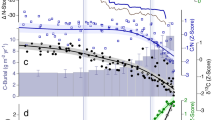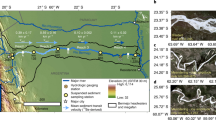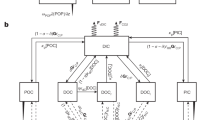Abstract
Several hypotheses have been proposed to explain recent, widespread increases in concentrations of dissolved organic carbon (DOC) in the surface waters of glaciated landscapes across eastern North America and northern and central Europe1,2,3. Some invoke anthropogenic forcing through mechanisms related to climate change3,4,5, nitrogen deposition6 or changes in land use7, and by implication suggest that current concentrations and fluxes are without precedent. All of these hypotheses imply that DOC levels will continue to rise, with unpredictable consequences for the global carbon cycle. Alternatively, it has been proposed that DOC concentrations are returning toward pre-industrial levels as a result of a gradual decline in the sulphate content of atmospheric deposition8,9,10. Here we show, through the assessment of time series data from 522 remote lakes and streams in North America and northern Europe, that rising trends in DOC between 1990 and 2004 can be concisely explained by a simple model based solely on changes in deposition chemistry and catchment acid-sensitivity. We demonstrate that DOC concentrations have increased in proportion to the rates at which atmospherically deposited anthropogenic sulphur and sea salt have declined. We conclude that acid deposition to these ecosystems has been partially buffered by changes in organic acidity and that the rise in DOC is integral to recovery from acidification. Over recent decades, deposition-driven increases in organic matter solubility may have increased the export of DOC to the oceans, a potentially important component of regional carbon balances11. The increase in DOC concentrations in these regions appears unrelated to other climatic factors.
This is a preview of subscription content, access via your institution
Access options
Subscribe to this journal
Receive 51 print issues and online access
$199.00 per year
only $3.90 per issue
Buy this article
- Purchase on Springer Link
- Instant access to full article PDF
Prices may be subject to local taxes which are calculated during checkout



Similar content being viewed by others
References
Roulet, N. & Moore, T. R. Browning the waters. Nature 444, 283–284 (2006)
Skjelkvåle, B. L. et al. Regional scale evidence for improvements in surface water chemistry 1990–2001. Environ. Pollut. 137, 165–176 (2005)
Worrall, F., Burt, T. & Shedden, R. Long term records of riverine dissolved organic matter. Biogeochemistry 64, 165–178 (2003)
Freeman, C., Evans, C. D., Monteith, D. T., Reynolds, B. & Fenner, N. Export of organic carbon from peat soils. Nature 412, 785 (2001)
Freeman, C. et al. Export of dissolved organic carbon from peatlands under elevated carbon dioxide levels. Nature 430, 195–198 (2004)
Findlay, S. E. G. Increased carbon transport in the Hudson River: unexpected consequence of nitrogen deposition? Frontiers Ecol. Environ. 3, 133–137 (2005)
Garnett, M. H., Ineson, P. & Stevenson, A. C. Effects of burning and grazing on carbon sequestration in a Pennine blanket bog. Holocene 10, 729–736 (2000)
Evans, C. D., Chapman, P. J., Clark, J. M., Monteith, D. T. & Cresser, M. S. Alternative explanations for rising dissolved organic carbon export from organic soils. Glob. Change Biol. 12, 1–10 (2006)
Stoddard, J. L. et al. Response of Surface Water Chemistry to the Clean Air Act Amendments of 1990. Report EPA/620/R-03/001 (US Environmental Protection Agency, Washington DC, 2003)
Vuorenmaa, J., Forsius, M. & Mannio, J. Increasing trends of total organic carbon concentrations in small forest lakes in Finland from 1987 to 2003. Sci. Total Environ. 365, 47–65 (2006)
Siemens, J. The European carbon budget: a gap. Science 302, 1681 (2003)
Evans, C. D. & Monteith, D. T. Chemical trends at lakes and streams in the UK Acid Waters Monitoring Network, 1988–2000: Evidence for recent recovery at a national scale. Hydrol. Earth Syst. Sci. 5, 351–366 (2001)
Alewell, C., Mitchell, M. J., Likens, G. E. & Krouse, H. R. Sources of stream sulfate at the Hubbard Brook Experimental Forest. Biogeochemistry 44, 281–299 (1999)
Tranvik, I. J. & Jansson, M. Terrestrial export of organic carbon. Nature 415, 861–862 (2002)
Hejzlar, J., Dubrovsky, M., Buchtele, J. & Ruzicka, M. The apparent and potential effects of climate change on the inferred concentration of dissolved organic matter in a temperate stream (the Malse River, South Bohemia). Sci. Total Environ. 310, 142–152 (2003)
Evans, C. D., Monteith, D. T. & Cooper, D. M. Long-term increases in surface water dissolved organic carbon: Observations, possible causes and environmental impacts. Environ. Pollut. 137, 55–71 (2005)
Zhu, Y. & Day, R. L. Analysis of streamflow trends and the effects of climate in Pennsylvania, 1971 to 2001. J. Am. Water Resour. Assoc. 41, 1393–1405 (2005)
de Wit, H. A., Hindar, A. & Hole, L. Winter climate affects long-term trends in stream water nitrate in acid-sensitive catchments in southern Norway. Hydrol. Earth Syst. Sci. 4, 3055–3085 (2007)
Whitfield, P. H. & Cannon, A. J. Recent variations in climate and hydrology in Canada. Can. Water Resour. J. 25, 19–65 (2000)
Hyvärinen, V. Trends and characteristics of hydrological time series in Finland. Nordic Hydrol. 34, 71–90 (2003)
Wright, R. F. et al. Trends in nitrogen deposition and leaching in acid-sensitive streams in Europe. Hydrol. Earth Syst. Sci. 5, 299–310 (2001)
Krug, E. C. & Frink, C. R. Acid rain on acid soil: a new perspective. Science 221, 520–525 (1983)
Clark, J. M., Chapman, P. J., Heathwaite, A. L. & Adamson, J. K. Suppression of dissolved organic carbon by sulphate induced acidification during simulated droughts. Environ. Sci. Technol. 40, 1776–1783 (2006)
de Wit, H. A., Groseth, T. & Mulder, J. Predicting aluminum and soil organic matter solubility using the mechanistic equilibrium model WHAM. Soil Sci. Soc. Am. J. 65, 1089–1100 (2001)
Vogt, R. D., Ranneklev, S. B. & Mykkelbost, T. C. The impact of acid treatment on soilwater chemistry at the HUMEX site. Environ. Int. 3, 277–286 (1994)
Tipping, E. & Hurley, M. A. A model of solid-solution interactions in acid organic soils, based on the complexation properties of humic substances. J. Soil Sci. 39, 505–519 (1988)
Tipping, E. & Woof, C. The distribution of humic substances between the solid and aqueous phases of acid organic soils; a description based on humic heterogeneity and charge-dependent sorption equilibria. J. Soil Sci. 42, 437–448 (1991)
Evans, A., Zelazny, L. W. & Zipper, C. E. Solution parameters influencing dissolved organic carbon levels in three forest soils. Soil Sci. Soc. Am. J. 52, 1789–1792 (1988)
Sokal, R. R. & Rohlf, F. J. Biometry 532–538 (W. H. Freeman, San Francisco, 1969)
Sen, P. K. On a class of aligned rank order tests in two-way layouts. Ann. Math. Stat. 39, 1115–1124 (1968)
Acknowledgements
We thank the LRTAP Working Group on Effects and the EU 6th Framework Programme Euro-limpacs for support in the production and analysis of international, quality-controlled, comparable data. We also acknowledge the work of the ICP Waters Programme Centre at the Norwegian Institute of Water Research (NIVA), where the data were collated, verified and archived. The authors are indebted to many colleagues and organisations who provided data for this assessment, including: T. A. Clair, S. Couture, C. Gagnon, D. K. McNicol, R. C. Weeber, A. Paterson (Canada); J. S. Kahl, J. Kellogg, K. Roy, M. R. Hale, D. R. DeWalle (USA); the Finnish Environment Institute (SYKE) and Regional Environment Centres; the Norwegian Institute of Water Research (NIVA); the Swedish Environmental Protection Agency (Naturvårdsverket); and the UK Acid Waters Monitoring Network (supported by the Department for Environment Food and Rural Affairs) and supporting laboratories at: Fisheries Research Services, Pitlochry; Centre for Ecology and Hydrology, Wallingford; and the Environment Agency Llanelli. The information in this document has been funded in part by the US Environmental Protection Agency. It has been subjected to review by the National Health and Environmental Effects Research Laboratory, and approved for publication. Approval does not signify that the contents reflect the views of the Agency, nor does mention of trade names or commercial products constitute endorsement or recommendation for use.
Author Contributions D.T.M. and J.L.S. formulated the working hypothesis and analysed and interpreted the trend data. C.D.E. and H.A.d.W. contributed to the development of the hypothesis, assisted in the interpretation of the data, provided additional text and edited the manuscript. M.F., T.H., A.W., B.L.S., D.S.J., B.K. and J. Vuorenmaa provided data and commented on the text. J.K. provided advice and ideas on processes and contributed data from the Czech Republic (not included in the final analysis due to number and length of time series) consistent with the hypothesis. J. Vesely contributed advice, ideas and data in the early stages of development of our work.
Author information
Authors and Affiliations
Corresponding author
Supplementary information
Supplementary Information
The file contains Supplementary Figures S1-S3 and Supplementary Tables S1-S5 with Legends. (PDF 744 kb)
Rights and permissions
About this article
Cite this article
Monteith, D., Stoddard, J., Evans, C. et al. Dissolved organic carbon trends resulting from changes in atmospheric deposition chemistry. Nature 450, 537–540 (2007). https://doi.org/10.1038/nature06316
Received:
Accepted:
Issue Date:
DOI: https://doi.org/10.1038/nature06316
This article is cited by
-
Pike Mercury Concentration in Small Boreal Headwater Lakes During Four Decades of Regional and Local Changes
Water, Air, & Soil Pollution (2024)
-
The hub of the wheel or hitchhikers? The potential influence of large avian herbivores on other trophic levels in wetland ecosystems
Hydrobiologia (2024)
-
Integrating Reservoirs into the Dissolved Organic Matter Versus Primary Production Paradigm: How Does Chlorophyll-a Change Across Dissolved Organic Carbon Concentrations in Reservoirs?
Ecosystems (2024)
-
Impacts of acid deposition and lake browning on long-term organic carbon storage in Canadian northern forest lakes
Journal of Paleolimnology (2024)
-
Seasonal fluctuations in pigment content of macrophytes: implications for monitoring brownification
Hydrobiologia (2024)
Comments
By submitting a comment you agree to abide by our Terms and Community Guidelines. If you find something abusive or that does not comply with our terms or guidelines please flag it as inappropriate.



